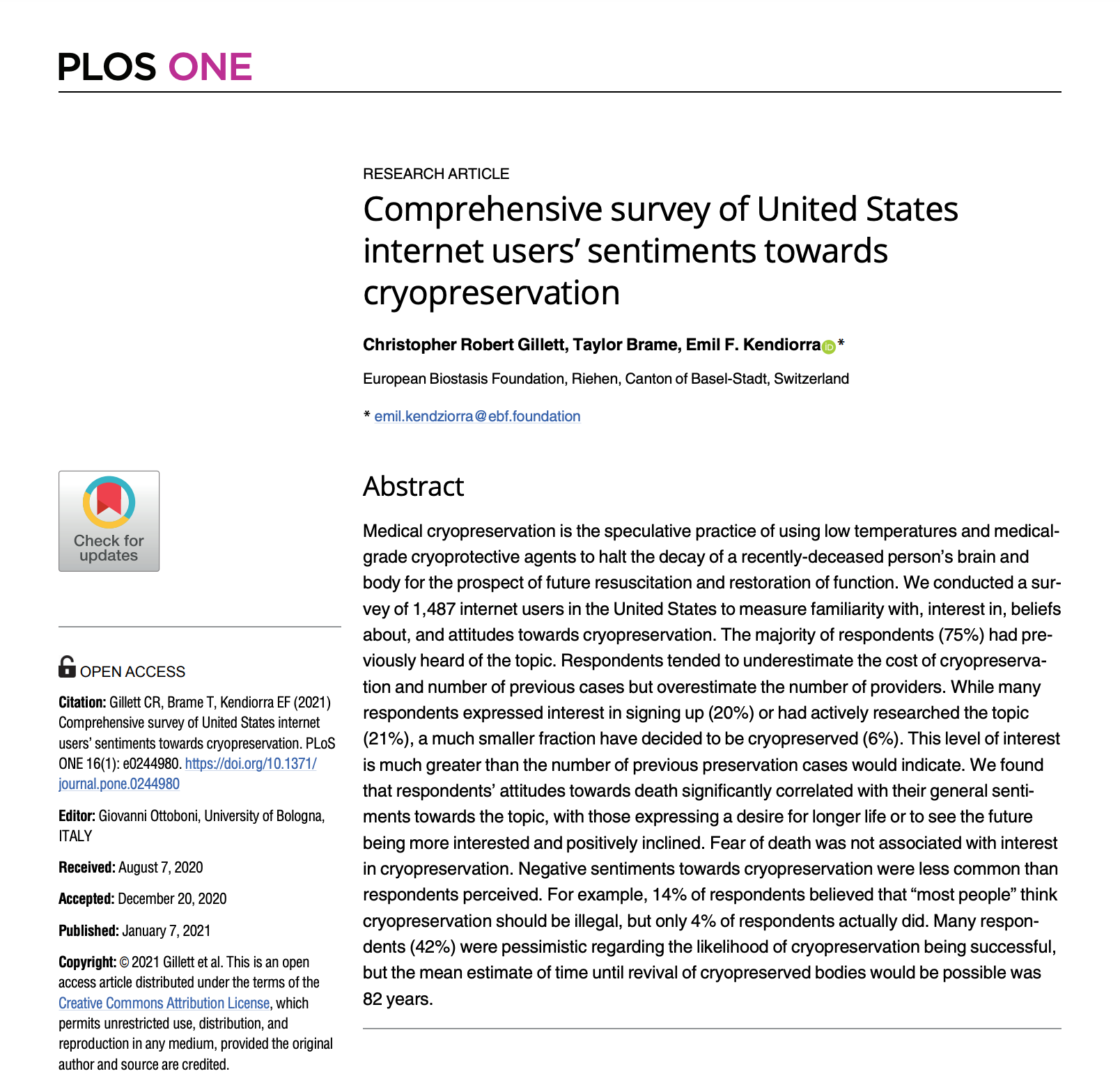Tomorrow’s R&D Priorities

(work in progress, we will continuously extent this list)
R&D is at the core of Tomorrow’s mission. In fact one of our primary long-term goals is to be able to continuously conduct and fund R&D — the other is providing the very best cryopreservation to our members. Growing is not an end in itself for us but a tool to be able to deploy the resources necessary for serious R&D projects. While the topics themselves might not be new for someone who’s been involved in this field for a while, it's important to have a clear understanding of how to prioritize.
On a high level Tomorrow’s R&D initiatives have two objectives:
1) What can we do today to improve the quality of a cryopreservation that might happen tomorrow? (This is mostly the Development side of R&D)
2) What R&D projects can we start now or soon to fundamentally advance the field in the long-term? (This is mostly the Research side of R&D)
While the separation into development and research is not clear cut, there is a meaningful difference. In other words, we plan to dedicate a part of our resources to iteratively and continuously improve the quality in smaller steps with clear short term results and tangible effects. Another part will be dedicated to long-term, high impact topics.
Development
Initially, we will mostly concentrate on the lower hanging fruits on the development side. The reasoning for that is two fold. Firstly, as an organization with significant in-house medical expertise and capability we’re set up to produce substantial improvements in the short and mid-term. And second, there is still significant existing knowledge that can be implemented into cryopreservation procedures (especially in Europe). Research projects on the other hand will initially be conducted in collaboration with others or simply funded by us.
Perfusion Protocols (WB Field Cryoprotection)
Currently, in most cases, either field washout (i.e. no on-site perfusion of cryoprotective agent) or a neuro-focus CPA perfusion is used. Protocols and equipment targeted at whole-body field cryoprotection/perfusion allows for local cooldown to dry ice temperatures, enabling longer transport times without degradation and higher quality cryopreservations.
Perfusion Technology
Perfusion equipment differs significantly between countries and organizations — from gravity-fed perfusion and embalmer pumps to medical-grade perfusion circuits. Historically, Europe has been rather rudimentary in this regard. Employing professional perfusion equipment and procedures is an important step to improve quality. For our whole-body cryoprotection procedure we will use professional medical-grade pumps and circuit setups (practically heart-lung machines) to improve quality with ideal pressure control, bubble-avoidance, pulsative flow, overpressure protection, etc. This setup will be enhanced continuously and additional local team trained to perfect response times.
Cooling Technology
Apart from implementing robust external and internal cooling (via cooled perfusate), novel cooling methods promise faster cooling rates leading to less warm ischemia. While currently already established in lab or hospital settings the complexity comes from the field application. Techniques likes liquid ventilation, gastric lavage or fast extracorporeal bypass (before significant cooling) all require significant skill, comprehensive training and last but not least procedures and equipment that are realistically and reproducibly usable.
Monitoring and Reporting
Improvements can only be made if comprehensive data to learn from is available. From automated monitoring, reporting solutions, and integrated sensors we focus on establishing protocols to collect, aggregate, report, and summarize (with full compliance) case data in a fast and exhaustive fashion.
Support, Trainings and Guides for Local Team
A good cryoprotection needs speed and skill. Speed to start cooling as soon as possible after circulatory arrest (and legally after pronouncement) and skill to perform a high-quality cryoprotection. Unfortunately, member numbers even for the largest organizations are not large enough yet to allow for multiple professional teams that can be at the patients site without significant delay. For now, a combination of local teams (to allow for fast initial cooling) combined with centrally positioned professional teams is the best solution. In most cases those local teams are part-time and volunteer organizations. To support them as best as possible, we’re organizing trainings, offering hands-on support and advice and developing extensive digital support tools to allow good standby in even remote locations.
Whole-body ITS (Intermediate temperature storage)
Most patients in cryopreservation are in “immersion storage”. This has been the standard for many years. And while it is well understood and comparatively easy to do and maintain, it brings some downsides. One of the most talked about difficulties is “fracturing”. During cool-down to -196°C, even if done very slowly, thermal stress develops in larger structures, which leads to the fracturing of the structures. This creates an additional need to repair once revival technology is possible. Cooling down less but still below the glass transition temperature would bring the same protective qualities of low temperatures without the same degree of thermal stress and in turn significantly less fracturing. Intermediate temperature storage is doing just that. We plan to implement the first whole-body ITS solution for cryopreservation patients.
Research
Research projects and initiatives are separated into applied or translational research (short/mid-term implementation horizon) and long-term or basic research (long to very long-term implementation horizon or theoretical stage). Please note that some of the long-term projects are currently in conceptual phase.
Group 1: Applied or Translational Research
i.e. short/mid-term implementation horizon or active proposals and initiatives.
Quality metrics
To improve in a goal-driven fashion, comprehensive outcome metrics are required. Similar to those in medicine such as 5-year survival rate for cancer or re-hospitalization and complication rate in operations. While some exist (e.g. extent of dehydration and ice formation measured by CT scan), significantly more work is required. Establishing new and improving existing metrics is a short/mid-term focus for us.
Improvement of Cryoprotective Agents (CPA)
The quality of cryoprotective agents is one of the most crucial factors determining overall quality. Our primary focus is the optimization for “real-world situations” as opposed to lab-settings. Lab settings are usually well controlled and ideal, real world situations much less so. Topics include the addition of blood-brain-barrier openers, optimization for transport times, edema reduction, optimization for different tissues types, etc.
New CPAs
Similar to improving existing CPAs, creating new ones — purpose-built for non-ideal (non-lab) situations — is a valuable endeavour. This has been tried in the past by multiple organizations without much/no improvement over existing options. There is interesting and promising basic research but translating it might pose significant challenges.
Toxicity Reduction and Markers
Some of the ingredients of CPAs are toxic, the toxicity can be reduced, for example, by combining ingredients that in combination are less toxic than they would be individually. Understanding toxicity better (by establishing markers) and reduction of toxicity is an important topic to limit the amount of cellular damage that needs to be repaired.
Group 2: Long-term or Basic Research
i.e. long- to very long-term implementation horizon or theoretical and conceptual stage.
Warming Protocols
Warming cryopreserved tissue, especially, when larger volumes are involved (such as organs or the brain) exacerbates the complexities involved in cryopreserving the tissue. Ice nucleation and formation, for example, is much harder to control while warming from cryogenic temperatures than when cooling down to them. Specific warming protocols and methods are required.
Reperfusion Protocols
To wash out CPAs and reestablish circulation the tissue needs to reperfused and resupplied with oxygen. This brings its own set of complexities such as reperfusion injury. Furthermore, fundamentally, the concepts to do perfusion after cryopreservation needs to be formulated.
Concepts for Repair
Everything that is done during the cryopreservation process is done to reduce the amount of cellular and sub-cellular damage incurred due to active and passive processes started after circulatory arrest and by the procedures themselves. Nevertheless, damage is still accumulating. In total, four types of damage will need to be repaired: 1) damage from before circulatory arrest (e.g. due to diseases or general degradation), 2) damage occurring after circulatory arrest due to ischemia (e.g. apoptotic and necrotic processes) , 3) damage from the cryopreservation itself (e.g. toxicity, ice nucleation, etc), and 4) damage from the warming and reperfusion procedures (e.g. ice nucleation).Some of the repairs probably need to be done at sub-zero temperatures, further complicating the issue. Needless to say, significant basic research is required to understand what is required to perform these repairs.
Restoration of Life
Last but not least, once warming, reperfusion and repair is understood and done, all procedures need to come together in a kind of “resuscitation” similar to how cardiopulmonary resuscitation is made up of different parts leading to the “restoration of life” in the case of a heart attack. Much conceptual and theoretical groundwork needs to be done before more applied research projects make sense.
For the time being its prudent to focus on improving the more tangible and applied cryopreservation procedures and development topics.



